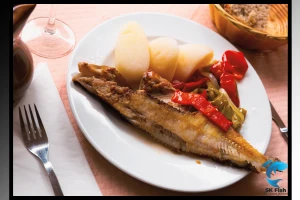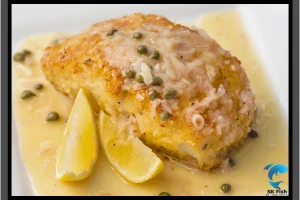Wahoo | Amazing Facts about Wahoo(Ono Fish) You Need to Know
Published: 17 Dec 2023
Welcome to the glamorous world of Wahoo. It is known as Ono Fish in Hawaii, which means “Good to eat”. It’s commonly referred to as Wahoo in other countries. The scientific name of Ono is Acanthocybium solandri and the Japanese name is kamasu-sawara.
Do you want to know about the taste and amazing facts about Ono fish? You’re in the right place. In this article, we will explore the fascinating facts and all the nuances of Ono fish. This article enlightens you about Ono fish’s amazing facts and delicious taste.
So, get ready to dive into the world of wahoo.
What is Wahoo Fish?
Meet the Wahoo, a fish with a strong silver body that looks like a supercharged sports car in the sea! Imagine the sleek torpedo body of a wahoo zooming through the water–it’s long and streamlined almost built for speed and agility.
Most of the people don’t know the real name of Ono fish. So, the real name of the Ono fish is “Wahoo (Acanthocybium solandri), ” a scombrid fish. But in other countries, it has different names. So, you can say any name of Wahoo that you love more. I love to say, Ono.
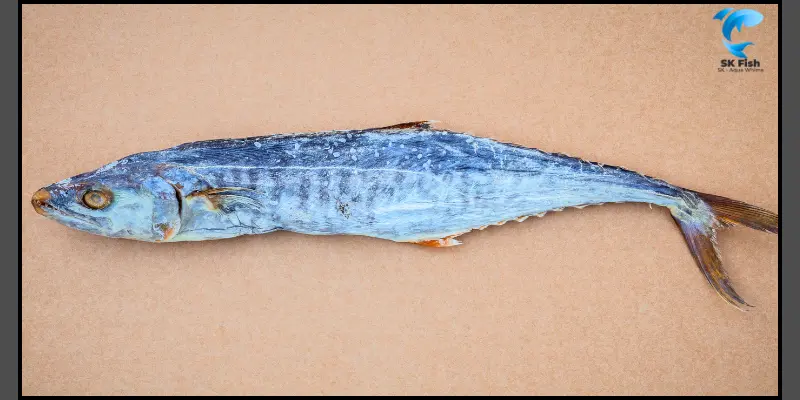
Common Names
Wahoo has different names in different countries, known as Pacific Kingfish, Queenfish, Kingfish, Peto, Guarapucu, Malata Kingfish, Thazard Batard, and more worldwide. In the US Wahoo is known as a “hoo”.
Weight and Length
There are millions of Wahoo living in seas worldwide. The maximum size of the Wahoo Fish can be 98 inches, but normally, the size of the Wahoo ranges from 40 to 65 inches. Ono may grow to more than 100 pounds, with the usual weight falling between 30 to 40 pounds. Ono fish swims very fast in the sea, reaching up to 48 mph.
Lifespan and Reproduction
Unfortunately, they have a very short lifespan of about 5 or 6 years. In the appealing underwater world of wahoos, reproduction involves a process.
During spawning, female wahoos release their eggs into the open water, and simultaneously male wahoos release their sperm. It’s like an alluring dance in the water, where the life of wahoos begins. This process is called Fertilization.
The fertilized eggs convert into larvae, which go through several stages before reaching maturity. They are very productive, releasing half a million to 45 million eggs annually.
How is the Taste of Wahoo Fish?
Let’s delve into the taste of Wahoo fish; trust me, Wahoo is not just a fish; it’s a flavor adventure. Many people ponder the taste of Wahoo fish. What is the taste of Wahoo fish?
Wahoo boasts one of the most delectable flavors among all fishes. When you try Ono fish, you’ll discover a taste similar to tuna. Taking a bite of Wahoo fish is an amazing experience. Its flavor is distinctly remarkable with a touch of sweetness.
Is Wahoo Good to Eat?
In Hawaii, the name of the Wahoo fish is Ono, and Ono means “Good to eat.” So, whether Wahoo is good to eat is unequivocally answered. Hawaii ono has a mild sweet flavor.
The Texture of Wahoo Fish
Let’s explore the texture of Ono fish. Wahoo’s meat is firm with a mild, delicate taste, providing an irresistible mouthwatering sensation. Raw Wahoo meat is less red than mackerel. When cooked, its color transitions to a pale pink, culminating in a mild white texture with an enticing aroma.
The Nutritional Magic of Wahoo Fish
Hawaii Ono is an outstandingly healthy source for the body, offering extra lean protein. Ono fish is rich in calcium and phosphorus, serving as an excellent source of minerals like iodine, zinc, magnesium, and potassium.
It’s not just Ono fish with a delicious taste; it’s a nutritional powerhouse. Wahoo is rich in omega-3 fatty acids, vitamins B3 & B6, phosphorus, niacin, and selenium. Its nutritional value is especially crucial for pregnant women.
Habitat and Distribution of Ono Fish
Embark on a journey through the vast seas as we delve into the enchanting habitat and distribution of Ono fish, the speedster of the seas.
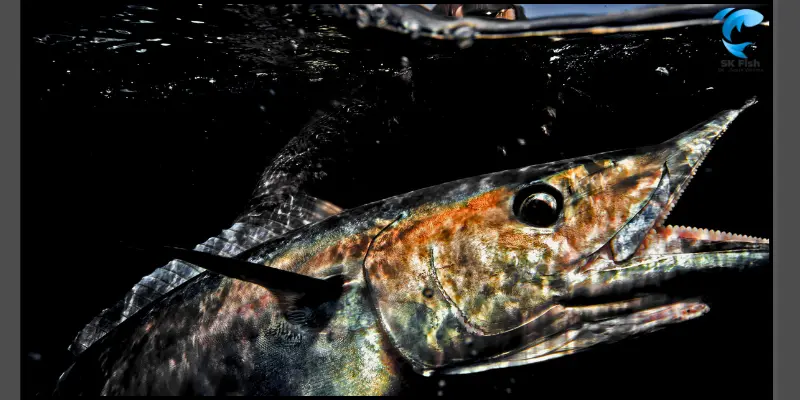
Versatile Habitat
Wahoos are found in tropical and subtropical seas around the world, spanning the Pacific, Atlantic, and Indian Oceans. They gracefully navigate the Caribbean and Gulf of Mexico, as well as the eastern coast of the United States. The Mediterranean seas also host these agile predators.
Temperature Zone
Preferring warmer waters, Wahoos predominantly inhabit regions with temperatures ranging between 24°C to 28°C. Remarkably, they explore depths of up to 1,000 feet. Wahoos, often solitary, cruise alone in the vast expanse of the ocean, showcasing their affinity for warmer temperatures and deeper realms, enhancing the mystique of these marine marvels.
Worldwide Range
Boasting a global distribution, Wahoos populate the Pacific, Atlantic, and Indian Oceans. Their presence extends from southern California, across Mexico, to the central Pacific Ocean, and reaches up to northern South Africa. This remarkable distribution underscores their adaptability to diverse oceanic environments.
Fishing Techniques: How to Catch Ono Fish
In the vast realm of fishing techniques, we explore fundamental and essential approaches to enhance your prowess in capturing the speedsters of the seas – the Wahoos. Renowned for their strength, these swift predators demand strategic methods. The following key points illuminate effective ways to reel in these oceanic marvels.
Different Methods to Catch Wahoo
A plethora of fishing techniques come into play when targeting Wahoo. The options are diverse from kite fishing and bait fishing to troll fishing, float fishing, and beyond.
Whether employing spearfishing, jigging, fly fishing, or opting for more traditional methods like shore fishing, drop lining, or net fishing, the arsenal of techniques caters to various preferences and environments.
Trolling Techniques
Contrary to the assumption that high-speed trolling is the exclusive method for Wahoos, the reality lies beyond sheer velocity. Trolling emerges as one of the most effective techniques, involving the art of towing lures behind the boat to entice these agile fish.
This versatile method finds application in diverse settings, be it the ocean, river, sea, or lake, irrespective of water depth. Tailored trolling approaches exist for specific species and locations. While the typical saltwater trolling speed ranges from 2 to 9 knots, the speedster reputation of Wahoos demands speeds of 14 to 18 knots, incorporating alluring lure action.
Personally, a preference for slow trolling has proven more effective, cruising at speeds between 8 to 10 knots to entice substantial catches.
Common Baits or Lures for Wahoo
An array of baits and lures adds to the angler’s toolkit for Wahoo. From ballyhoo and skirted lures to bullet head lures, strip baits, live baits, daisy chains, soft plastic lures, rattle jut lures and hybrid trolling spoons, the options are diverse and adaptable to varying conditions.
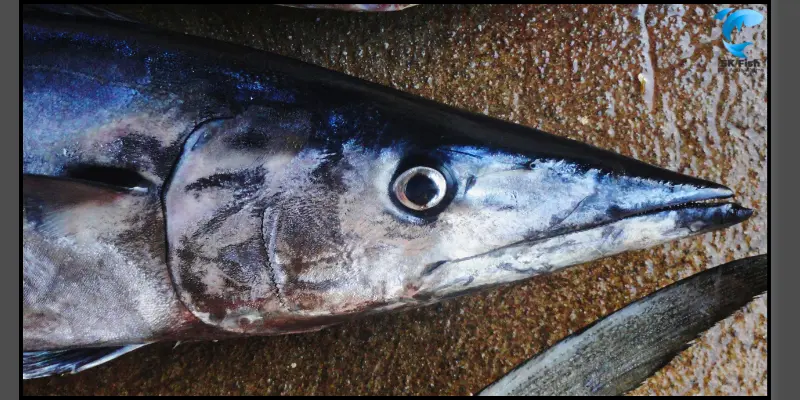
Diet and Feeding Habits of The Ono FIsh
Wahoo is a pelagic predator and has a distinct diet. Some useful details about the diet of Ono fish are given below.
Preyed Fishes of Wahoo
In the obsidian depths of the ocean, Wahoo, the pelagic predator, orchestrates its culinary endeavors with precision. Among the preyed fishes, Wahoo showcases a penchant for the dark corners of the sea. Its menu includes a diverse selection: Bonito, flying fish, mackerel, tuna, squid, gurnard, saury (halfbeak), ballyhoo, frillfin goby, and butterfish.
Feeding Zones of Hawaii Ono
In the fluid ballet of the seas, Hawaiian fish celebrated as the speedsters of the oceans, wield authoritative hunting prowess. Their feeding habits unfold as a dynamic dance, intricately tied to their location.
While Wahoos often grace the surface in pursuit of prey, their adaptability extends to deep-sea dives, transforming them into formidable predators across the globe’s expansive oceans.
Scent and Lure Recognition
Wahoos, armed with a keen sense of smell, emerge as clever tacticians in the art of detection. Their ability to discern scents in the water, especially those of injured fish, plays a pivotal role in their adept detection of prey.
In the realm where scent becomes a language, Wahoos master the art of recognition, underscoring their prowess as skilled hunters in the vast aquatic expanse.
Culinary Uses of Hawaiian Fish Ono
Now, let’s start to discuss the culinary uses of Ono fish. We know that Wahoo is renowned for its amazing facts and benefits.
Different Cooking Methods of Ono Wahoo
Wahoo is renowned for its firm, mild-flavored versatility in the kitchen. Wahoo’s flesh boasts a mild and sweet flavor in different ways. We use wahoo in various cooking methods such as grilling, baking, blackened wahoo, seared, stuffed portobello, Lainie’s wahoo marinade, pan-seared wahoo, wahoo salad, seared wahoo with mango salsa, wahoo fries, grilled wahoo Caribbean, battered wahoo fish tacos, and pan-roasted wahoo.
| Interesting Facts about Ono Fish |
|---|
|
Conclusion
In this article, we explored all the nuances of Ono fish. Now, we know all the facts about Ono fish, such as their common names, reproduction, weight and length, lifespan and reproduction. We also understand the tastes of wahoo fish, their habitat and distribution, fishing techniques, diet and feeding habits, culinary uses of wahoo, and their interesting facts.
I hope this article enlightened you about the charming facts of Ono fish and was helpful to you. Share your feedback in the comment section.
Commonly Asked Question
What is another name for wahoo fish?
The scientific name of Wahoo is Acanthocybium solandri. The Japanese name of Wahoo is kamasu-sawara. In Hawaii, wahoo is known as Ono fish. In the US wahoo is known as “hoo”. Wahoo has many common names in different countries.
How is the taste of Ono Fish?
As we know, in Hawaii wahoo is renowned as Ono fish. And the Ono means, “Good to eat”. So, Wahoo has a firm, mild delicious taste from all the fish. Wahoo has a fantastic pale pink color when it is grilled.
Is Wahoo good to eat?
Yes, Wahoo is an outstanding healthy source for our body because of its nutritional value. Ono fish is rich in a great source of minerals. Also, it is a nutritional powerhouse and is especially crucial for pregnant women
Is Wahoo a tuna?
Most people are stuck in the that a wahoo is a tuna. But, a wahoo is not a tuna it is related to tuna. They both are related to the Scombrid family. Also, the wahoo is close to mackerel.
Is Wahoo fish is same as the kingfish?
Wahoo is renowned for its speed. Wahoo is one of the fastest fish in the oceans of the world. Wahoo is known as a Pacific Kingfish in different countries.

SK Fish is your trusted source for practical fish care tips and delicious seafood recipes. Our team is dedicated to providing reliable, well-researched content for fishing enthusiasts and home cooks alike.

- Be Respectful
- Stay Relevant
- Stay Positive
- True Feedback
- Encourage Discussion
- Avoid Spamming
- No Fake News
- Don't Copy-Paste
- No Personal Attacks



- Be Respectful
- Stay Relevant
- Stay Positive
- True Feedback
- Encourage Discussion
- Avoid Spamming
- No Fake News
- Don't Copy-Paste
- No Personal Attacks
